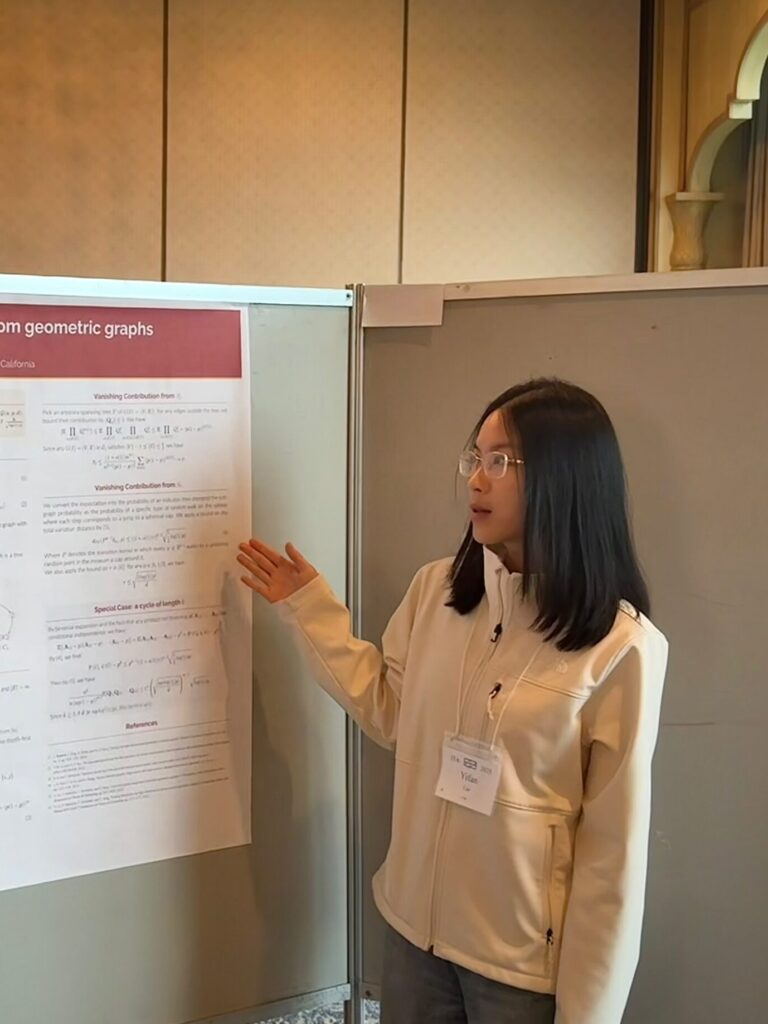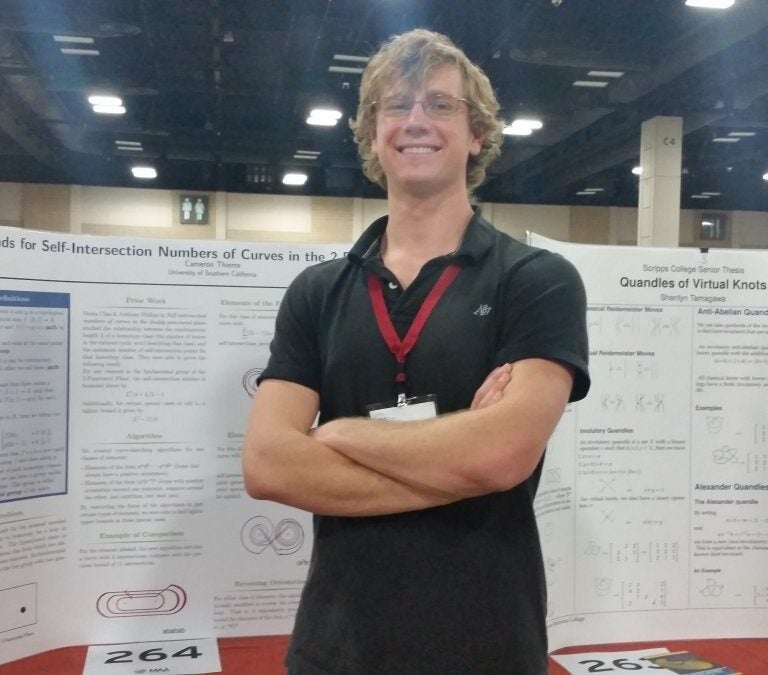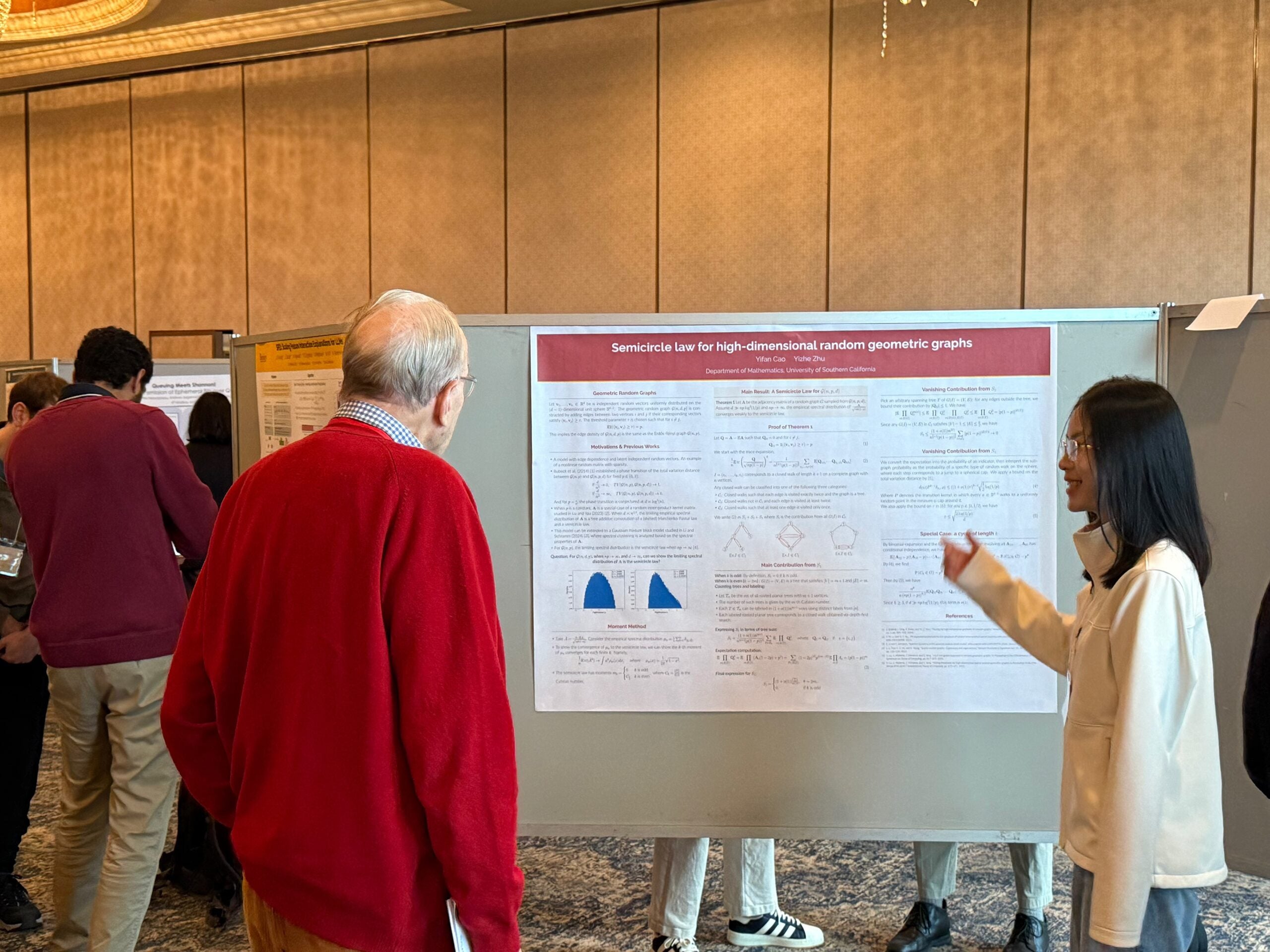The Department of Mathematics at USC encourages highly motivated undergraduate mathematics majors to seek research experiences. Undergraduate research is becoming essential for students who are planning on applying for a graduate program in the mathematical sciences. But any passionate, intellectually curious student wondering what such experiences in mathematics is like, should also try to find research experiences.

Undergraduate Research Opportunities
Research opportunities, in the form of semester long projects (in the Fall, Spring or sometimes Summer) are offered by some the faculty in the Department. Other faculty are also open to working with students who have excelled in their courses. Please speak with your favorite professor about what research opportunities s/he may have. Also, if you already have a strong interest in a specific subfield of mathematics (algebra, analysis, number theory, probability, topology, statistics and many more…), you are encouraged to talk to a faculty expert in that field.
Please be aware that some of the faculty in the Department may not have a project available for you and/or may simply not have the time necessary to work with you on a given semester. Also faculty may want you to satisfy some requirements from you in order to work on a project (for example, you may be asked to take a particular math class first).

How to get started
Students are also encouraged to seek opportunities outside USC such as REU (Research Experience for Undergraduates) programs. These are competitive summer programs run at different institutions in the country and supported by the National Science Foundation. You can find more information on the following webpage: http://www.nsf.gov/crssprgm/reu/list_result.jsp?unitid=5044
If you need advice or help getting started, want information on how to find a faculty mentor with a project, or if you are just wondering if undergraduate research in mathematics is right for you, please view the list of faculty profiles regarding undergraduate research.
Sampling of Current and Past Research Project Topics:
-
Our goal for this project is to study the asymptotic behavior of singular values of certain large random matrices. Under the perspective of point process, the local fluctuations near any non maximal or minimal point singular value gives a determinantal correlated point process with the Sine kernel, while fluctuations near the largest singular value (soft edge) gives a determinantal correlated point process with the Airy kernel. Our analysis utilizes a novel double contour integral formula obtained from a limit of specialized Schur measures. We were then able to perform asymptotic analysis based on the method of steepest descent using this integral representation for the correlation kernel. This work was presented at the poster session of JMM 2025.
-
We studied the spectral properties of high-dimensional geometric random graphs using techniques from random matrix theory and graph theory. The geometric random graph is a network model in which edges are formed based on similarity of latent random vectors on the unit sphere, with connections to kernel methods, nonlinear random matrices and manifold learning. Our results establish conditions under which the adjacency matrix follows the semicircle law in the high-dimensional regime. This work was presented as a talk at the JMM Undergraduate Session in January 2025 and as a poster at the Information Theory and Applications (ITA) Workshop in February 2025.
This work is by Wendy Cao supervised by Yizhe Zhu.

Wendy Cao at Information Theory and Applications (ITA) Workshop in February 2025 
Wendy Cao at Information Theory and Applications (ITA) Workshop in February 2025 -
The Anti-de Sitter/Conformal Field Theory correspondence is a conjectured relationship between two kinds of physical theories: quantum gravity on Anti-de Sitter spaces and conformal field theory on the boundary of these spaces. Physicists have become interested in a discrete analog of this correspondence that can be formulated over the Bruhat-Tits tree. In my research, I proposed that we expand the theory by using the Berkovich projective line instead of the Bruhat-Tits tree, and I demonstrated the feasibility of this by constructing (a subspace of) the Berkovich line as a quotient of a product of non-Archimedean fields.This work was presented at seminars at Caltech and Tsinghua University in China and the paper is available on the arxiv, which can be found here: https://arxiv.org/abs/2306.10227
-
The fundamental group of a topological space X is the set, equipped with a group structure, of all homotopy classes of closed curves on X. Two curves are homotopic to each other if one can be continuously deformed into the other. The 2-punctured plane can be thought of as the two-dimensional plane from which two disjoint open discs have been removed. Its fundamental group is isomorphic to the free group with two generators.Given a homotopy class of closed loops on the 2-puncured plane, we are interested in finding the loop(s) in that class with the minimal number of self intersections.
Although some bounds are already known, they tend to be very wide in general and in a lot of cases, they are not tight.
In this project, we are trying to find finer bounds for the minimal number of self-intersections for some certain types of elements of the fundamental group of the 2-punctured plane.
This work has been done during the Summer 2014 (and ongoing in the Spring 2015) by Cameron Thieme supervised by David Crombecque.
-
The Clean Water Act, section 303(d) mandates testing water bodies to determine which may be ‘impaired’. Testing is presently conducted using an exact binomial test with balanced Type I and Type II errors. However, under the same statistical assumptions, it is possible to reduce the average number of samples required using a statistical method called the sequential probability ratio test (SPRT). Doing so would result in a potentially large cost savings in regulatory compliance testing, which could then be redirected toward other environmental planning needs. The SPRT analog to the exact binomial test determines after each sample whether additional evidence is needed, or whether the current evidence is strong enough to assign a `pass’ or `fail’ conclusion.
Professors Jay Bartroff and Larry Goldstein, supervising Connie Chen, in collaboration with Mathew Gribble.
-
With access to a consumer’s purchase history, it is relatively simple to predict whether he/she will take advantage of a specific promotion. A more challenging problem is to predict whether a customer will be a repeat purchaser of an item once the promotion has been lifted. The data science competition website Kaggle hosted a challenge in which teams were provided with approximately 350 million rows of anonymized transactional data from over 300,000 shoppers. The task was to use this data to predict whether customers would be repeat purchasers of specific promotional items. An efficient algorithm will enable companies to save large sums of money by offering more efficiently targeted promotions.
Professors Gary Rosen and Neelesh Tiruviluamala, supervising Kira Soderstrom.
-
The American Epilepsy Society sponsored a challenge though Kaggle in which teams competed to find the best seizure prediction algorithm. Several gigabytes of electroencephalography (EEG) readings were provided from both canine and human subjects. The task was to classify a large number of ten minute clips as preictal (occurring immediately before a seizure) or interictal (occurring at a time when no seizures are imminent). The team used ideas from Fourier Analysis to extract features and it used a neural networks algorithm to make predictions. The team of USC undergraduates placed 14th out of more than 500 competing teams.
Professor Neelesh Tiruviluamala, supervising Justin Tran, Frank Jia, Kira Soderstrom, Erin Mills, Hunter Holland, Curren Mehta, Anisha Pathak, Qi Yang, and Eugenio Rivera with the help of computational biology PhD student Asif Zubair.
-
An accurate gauge of the distribution of the various plankton in an ocean ecosystem is useful in determining ocean health. Plankton populations are monitored using underwater imagery sensors which capture an enormous number of plankton images on a daily basis. Since each plankton can not be classified by hand, computer vision algorithms can be used to automate this process. The Hatfield Marine Science Center at Oregon State University has provided the competition website Kaggle with tens of thousands of plankton images. Teams will compete to produce the most accurate and efficient classification algorithm.
Professor Neelesh Tiruviluamala, supervising Luis Vidalon-Suzuki, Justin Ho Ching, Qi Yang, Ramy Fahim, Abby Widtfeldt, Joseph Vanderlans, Christian Lau, Shih-Hau Yu, Kira Soderstrom, Jacob Stewart, Robert Wu, Rui Zhao, and Tina Huang with the help of computational biology PhD student Asif Zubair.
-
The EPA has tested thousands of chemicals using multiple in vitro high-throughput screening assays in order to determine the extent to which they interfere with the normal functioning of the Estrogen Receptor (ER) pathway. The ER pathway is a complex sequence of biological processes and the assays are themselves biological processes that are noisy and can detect activities not associated with the pathway. This means it is non-trivial to determine the interference of the chemicals from the data.
Our work has focussed on developing
a) a mathematical model of the response of the assays based on the levels of activity of the chemicals at different points along the ER pathway
and
b) a criterion based on these levels of activity that encapsulate the interference of the chemicals with the normal functioning of the ER pathway.
Using our model and the assay response data, our goal is to estimate the levels of activities of the chemicals and using our criterion based on these levels of activity we will then determine the interference of each chemical with the ER pathway. The challenge is to develop a model that is sophisticated enough to capture the behaviors of the chemicals and yet simple enough to permit us to estimate the parameters from the data. The performance of our model and criterion will be tested on a collection of 36 reference chemicals and used to evaluate the interference of the full set of 1777 chemicals.
Professor Cymra Haskell supervising Ziyue Wu and Yifan Sun.